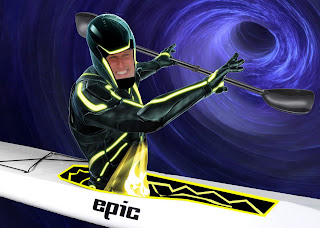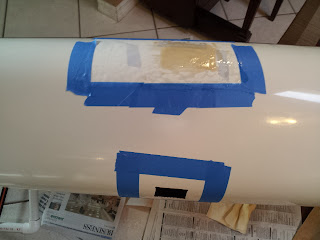Improving Paddling Stroke for speed and efficiency
I am mostly a surfski paddler... similar to a K-1 but for the ocean. I have raced for many years and every year I learn more and more about my stroke. I also race OC-1, OC-6 and Dragon Boats. In this article, we will only address kayak, K-1 and Surfski paddling stroke style.
Last year, I realized that I needed to focus on sprints to get a better race start. This year, I believe I am focusing on an even more important and more basic part of the stroke, the catch, stroke and release.
My stroke was not clean enough, not generating as much power as some of my fellow paddlers paddling at the same pace. Their boats were going faster! I recognized something was wrong so I went to work fixing it. It took nearly 6 months of focused work.
Steps to an efficient paddling stroke used by the pros:
1) One of my training partners said it best, "draw your paddle like a bow and arrow." To draw this bow you must turn your entire upper body and keep your lower arm fully extended.
2) Enter "the catch" very gently without splash.
3) Keeping the extended arm straight, push forward with the rear upper arm until it is also extended.
4) At the point that the rear arm reaches extension, your paddle will have moved back to the "power phase" of the stroke. At this point, turning the torso, add torso strength to your stroke.
5) Remove the blade at a comfortable location alongside the hip "the release" so that you can simply raise the rear hand and immediately draw the bow and arrow again into your next stroke.
***Note that the height of your arms is very important. You must keep them even with the shoulders. Too low, sloppy technique. Too high you will get tired quickly. Try holding both arms straight out with your paddle. It's comfortable. Higher and you feel the strain on your arms. Unfortunately, most paddlers hold their arms under shoulder height due to the comfort of the position and gain bad technique.
***Note that your arms will remain almost totally straight except for a slight bend in the elbow at the point right after the release as you draw the bow and arrow.
***Note that this stroke style is for any kayak but absolutely necessary for improving your performance in a high-end K-1 or Surfski.
***To increase performance, endurance and balance, I would never use anything except a Wing Paddle. A wing paddle is absolutely necessary to maintain balance in a narrow high-end boat. If you do not use one, your speed will be greatly reduced especially on gulf or ocean waters. I use a Fenn or Epic Endurance Wing paddle.
This stroke will be angled away from the boat at a different angle depending on the width of your boat. Yes, each boat is different. If the boat is thinner, the angle will be smaller. If the boat is wider, the angle will be larger. You must practice to figure out the exact angle that will put your paddle in perfect exit position to immediately spear the other end of the paddle into the catch. I like boats that offer a cut-out for the catch. My current Epic v10L does not have this but the Epic v12 does.
***You must use "leg drive" in any type of kayak. You can't paddle well without leg drive. You must do both stroke and leg drive at the same time or you will lose both stability and a solid flow of power into your paddling stroke. Leg drive is the extension of the leg through the power stroke & on the same side as your stroke.
Many paddlers believe that you must paddle for long distances and high intensity intervals to improve. Not so. In martial arts I learned an important lesson that needs to be incorporated into paddle training... If you can't do it right slow, you aren't doing it right fast. Slow down & take time to do short drills and practice focusing on just one small aspect of paddling technique at a time. Then paddle slowly in an attempt to remain consistent while incorporating all of the individual focus areas. This should be done weekly on flat water. More can be gained by doing these drills than interval training, endurance training, etc. I am not diminishing the need for either of these but if you don't have the basics right then you are doing it wrong over and over reinforcing bad habits.
Then test these skills out in gulf or ocean conditions as well to gain even greater skills and you will be less tired and much faster. These will test your trust of technique. Your tendency will be to lower your arms in waves or chop. Resist that temptation. Keep them shoulder level.
Then and only then, you can go back to doing endurance and interval training but don't forget to still do slow drills each week to focus on improving technique and making it a smooth natural body movement.
Do any move over 10,000 times and it becomes an natural movement you can do it without thought. 10,000 correct slow practice technique drills will give you much more than 10,000 wild thrashing movements with a paddle. Focus on the basics. Your technique will very slowly improve over the years.
I suggest training with a GPS watch or GPS device that you can attach to the bow. This will help show you how efficient your stroke is. Effort does not = speed. You may feel like you are paddling "harder" but not increasing speed at all. Technique, technique, technique. Paddle several miles trying to flow consistently so that your technique becomes smooth.
***I would like to credit several mentor training partners who have contributed to my personal understanding and interpretation of technique over the years: Brent Postma, Karl Vogel and Oscar Chalupsky. My technique is uniquely different than all 3 yet most strongly influenced by them.
Enjoy the process of becoming a professional competition paddler!
- Steve Hunter Tampa Bay, Florida USA




Comments
Post a Comment
Feel free to ask questions or share your knowledge